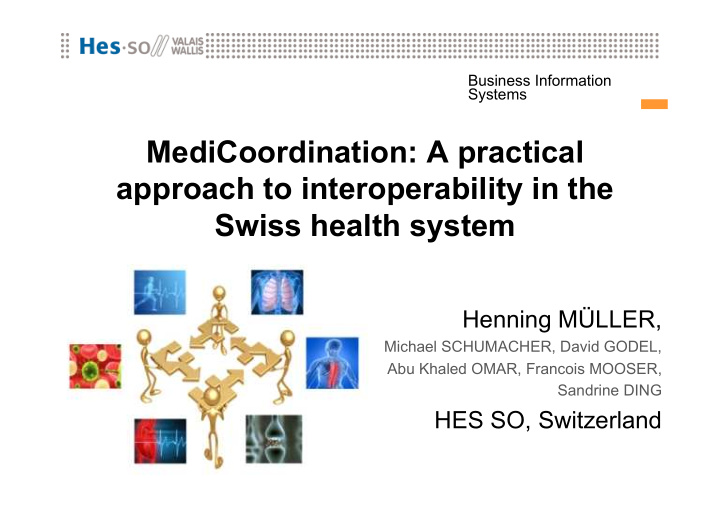



Business Information Systems MediCoordination: A practical approach to interoperability in the Swiss health system Henning MÜLLER, Michael SCHUMACHER, David GODEL, Abu Khaled OMAR, Francois MOOSER, Sandrine DING HES SO, Switzerland
Business Information Systems Overview • Introduction – The Swiss health system • Goals of Medicoordiation • Concrete steps – Interviews – Scenario for a prototype • Conclusions
Business Information Systems Introduction • Most European countries have eHealth strategies for interoperability – Health cards, direct communication between partners, … • Many independent partners are involved – Association of GPs, association of hospitals, health insurances, … • Very political subject as all citizens are concerned about their health data
Business Information Systems The Swiss Health System • Extremely scattered as health is in the responsibility of the 26 cantons – Much varies from one canton to another – Very little can de decided centrally – Decisions may take a long time • eHealth is a political subject (here as well) – Partners have conflicting interests • Comparably small market – Limited interest of the large companies
Business Information Systems The Swiss eHealth strategy • Coordination in several sectors connecting interest groups and experts – Work on recommendations for interoperability standards, teaching, legal issues • Very little legal power, recommendations only • Strategy over the next 10 years with clear goals • Bring together partners regularly – To agree on steps and standards – Keep all partners informed
Business Information Systems Goals of Medicoordination • No basic research but a practical approach – No strategy but concrete prototypes • Get opinion of all partners in the health system – Through interviews – Indentify areas of high added value • Concentrate on smaller, regional hospitals that have less resources for implementation – And on the Swiss French part • Base everything on the Swiss eHealth strategy – Standards, …
Business Information Systems First steps: identify partners in health • Two large University hospitals, two private hospitals • Six medium size regional hospitals • Two independent laboratories, a radiology lab for medical imaging • One insurance company • One producer of a GP medical record and two GPs • One producer of a clinical information system • The Swiss society for GPs • Several regional health boards
Business Information Systems Questions asked • Qualitative survey, around 45-90 minutes • Which electronic patient record is used and what exactly is digital? • Which standards and terminologies are used, or even entire data models (such as HL7 RIM)? • What is your attitude towards interoperability and data exchange? What is the potential and where are the risks? • Which scenarios would help you concretely in exchanging data with external actors?
Business Information Systems Results • Partners were very cooperative – Much information was exchanged – Different opinions on risks became clear • Everyone has a high interest in electronic data exchange – Potential benefits are very important • Concrete advantages need to be shown – Not only discussions on costs and abstract estimations of gains
Business Information Systems Use cases chosen • Interoperability of hospitals with external actors was the goal • Chosen scenarios were: – Quick electronic release note – Electronic discharge summary – Transmission of the operation protocol – Transmission of laboratory results – Transmission of images • Simple transmission of PDF was regarded sufficient (ID information in XML)
Business Information Systems Use case for the interoperability
Business Information Systems Steps to create the discharge summary
Business Information Systems Overall security model
Business Information Systems Current implementation state • Servers are installed in the DMZ in the two participating hospitals (Sion, Fribourg) • A directory is permanently controlled for arriving files (XML and PDF) • New files are imported into a database • An external GP can access a connector and download files attributed to him – Simple authentication – Transfer in HL7 XML format – Not tested on real data, only test data sets
Business Information Systems Overview of the current system
Business Information Systems Obstacles in the process • Management of a server in the DMZ of hospitals is not easy (responsibilities) – Security is the most important aspect • PDF was chosen over more structured data – Hospitals do not control the entire info system – Not all data is acquired in structured form • Standards are sometimes complex • Many people are involved in the process • Identification of patients is not easy – Will change with the Swiss health card
Business Information Systems Conclusions • eHealth and interoperability will become increasingly important in most European countries • Data availability will improve care and administrative processes • Overall gain is much higher than questions of individual actors in the health system • Concrete examples need to show benefit of eHealth instead of extremely large system
Business Information Systems Next steps • Test the system with real data – With few test patients – With larger amount of data • Show the added value to the partners – Prepare cantonal tests – Public private partnerships • Collaborate with networks such as eToile in Geneva
Business Information Systems Questions? • http://www.medicoordination.ch/
Recommend
More recommend